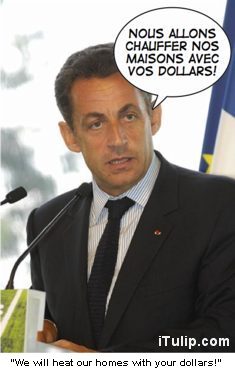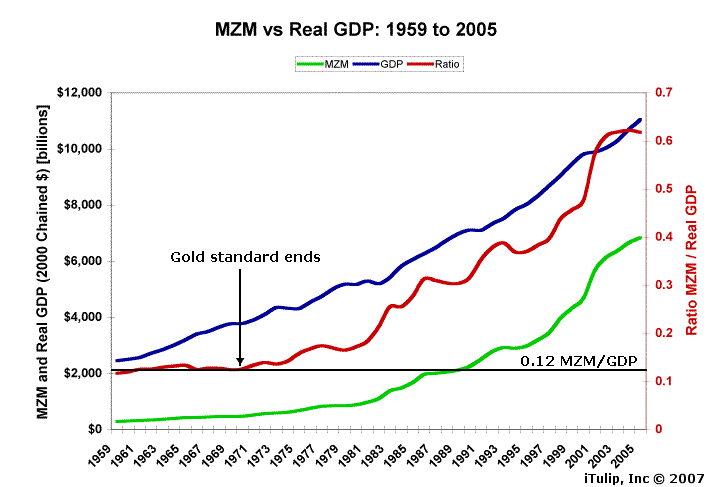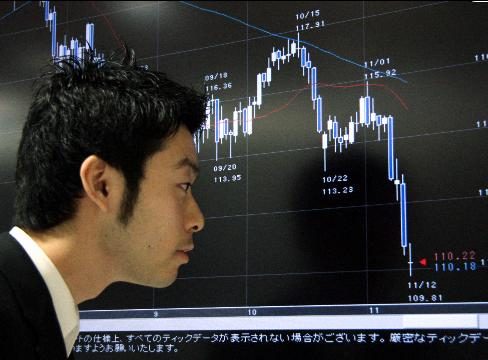 |
French President Nicolas Sarkozy and another rhyme of history.
It could have gone better. At the start of the new Presidential administration in 1969 at last a stylistic peer of the irascible French President Charles de Gaulle had appeared in the person of the new US President, Richard M. Nixon, or so it was hoped:
"Charles de Gaulle has not been an admirer of U.S. Presidents. According to Author Pierre Galante, he called Franklin Roosevelt "a false witness," Harry Truman "a merchant." Of Dwight Eisenhower, he said: "I am told that on the golf links he is better at putting than he is with the long shots. This does not surprise me." To De Gaulle, John Kennedy "had the style of a hairdresser's assistant—he combed his way through problems." Lyndon Johnson was like "a truck driver or a stevedore—or a legionnaire." Nixon and the general should strike it off fairly well. Both are direct, practical men, and De Gaulle showed characteristic prescience in granting Nixon a 40-minute interview in June 1967—at a time when De Gaulle would not have welcomed L.B.J. into the Foreign Legion. De Gaulle respects a tough adversary, and Nixon has been advised to be polite but firm."
A VOYAGE OF REDISCOVERY AND RECONCILIATION, TIME Magazine, Feb. 28, 1969
Alas, De Gaulle's inflammatory words and deeds on monetary matters rendered this promising partnership dead on arrival of Nixon to the Whitehouse:A VOYAGE OF REDISCOVERY AND RECONCILIATION, TIME Magazine, Feb. 28, 1969
Perhaps never before had a chief of state launched such an open assault on the monetary power of a friendly nation. Nor had anyone of such stature made so sweeping a criticism of the international monetary system since its founding in 1944. There was Charles de Gaulle last week proclaiming that the primacy of the dollar in international dealings was finished, calling for an eventual return to the gold standard —which the world's nations scrapped 50 years ago — and practically inviting other countries to follow France's lead and cash in their dollars for gold.
It was a particularly nettling irritant just as the U.S. was deeply involved in making some hard decisions about its monetary policy.
The Drain. President Johnson faces the unpleasant task of producing what he calls "strong and specific" actions to deal with the persistent U.S. balance-of-payments deficit, a problem intimately related to gold. The President's advisers are still debating just how "strong" these imminent measures should be.
There is a growing awareness, heightened by De Gaulle's offensive, that past attempts to close the payments gap have been mere palliatives — and that the problem has begun to undermine U.S. influence around the globe.
Just before De Gaulle spoke, Treasury Secretary Douglas Dillon made the first public admission that the U.S. payments deficit in 1964 moved higher than anyone had expected. It totaled about $3 billion, all of which the U.S. is legally committed to exchange for U.S. gold on demand. The Federal Reserve announced that the U.S. gold supply declined last week by $100 million, to a 26-year low of $15.1 billion.
De Gaulle v. the Dollar, TIME Magazine, Feb. 12, 1965
The same TIME article that proposed a happy first meeting between De Gaulle and Nixon reported De Gaulle's continued goading of US monetary leadership: |
The Drain. President Johnson faces the unpleasant task of producing what he calls "strong and specific" actions to deal with the persistent U.S. balance-of-payments deficit, a problem intimately related to gold. The President's advisers are still debating just how "strong" these imminent measures should be.
There is a growing awareness, heightened by De Gaulle's offensive, that past attempts to close the payments gap have been mere palliatives — and that the problem has begun to undermine U.S. influence around the globe.
Just before De Gaulle spoke, Treasury Secretary Douglas Dillon made the first public admission that the U.S. payments deficit in 1964 moved higher than anyone had expected. It totaled about $3 billion, all of which the U.S. is legally committed to exchange for U.S. gold on demand. The Federal Reserve announced that the U.S. gold supply declined last week by $100 million, to a 26-year low of $15.1 billion.
De Gaulle v. the Dollar, TIME Magazine, Feb. 12, 1965
"Despite the vicissitudes of the franc, De Gaulle insists that gold should ultimately be the sole international monetary standard, and that its official price must be increased, thereby devaluing the dollar. The threat of a fresh monetary crisis will dominate the Nixon-De Gaulle conversations. France's President hopes either to avoid that crisis altogether, or, if it comes, to make sure that it is not blamed on him alone. To that end, he wants joint efforts by the U.S., Britain and France to contain inflation and improve their balance of payments positions. Otherwise, he might have to devalue the franc by 20% or more—which would set off a shock wave of devaluations and imperil both the dollar and the pound."
A VOYAGE OF REDISCOVERY AND RECONCILIATION, TIME Magazine, Feb. 28, 1969
Younger readers wonder what it was all about. A VOYAGE OF REDISCOVERY AND RECONCILIATION, TIME Magazine, Feb. 28, 1969
Back in the old days, before it was "learned" that "payments deficits don't matter" and currency values started to be measured with the rubber ruler of government statistics they were measured using an immutable frame of reference: gold. A nation need not worry that its loan to another might be repaid in devalued currency. If France was concerned that the US had devalued the dollar and was repaying its debts to France with cheapened dollars, it could assert its right to demand payment in gold instead of paper. It was a free market monetary system for determining currency values. It offered governments no easy avenues for currency manipulation. If an international gold standard were in place today, China might demand a repricing of gold to devalue the dollar against gold to reflect the dollar's true exchange rate value rather than accept depreciation of its vast hoard of US Treasury bills. Or China could legally demand US gold instead, surely more than the US possess; US gold reserves of 8,133.5 tons are worth $208 billion today while China holds US dollar reserves in excess of $1.2 trillion. The international gold standard was a strict market-based taskmaster, making currency and trade imbalances transparent and leaving politicians with no place to hide out.
In the late 1960s, much as today, the US Treasury claimed a strong dollar policy but rising inflation in the US and among US trade partners told another story. De Gaulle wasn't buying the strong dollar tale and demanded not only payment of French debts with US gold but encouraged other European nations to do likewise.
Politicians love free markets the way Bostonians love the Red Sox–a lot when they are doing well, not at all when they aren't. Nixon got busy working out a way to repay the debts that the US had run up with its European trade partners with an asset less expensive to attain than gold. Paying the debts with an asset as cheaply and easily produced as Treasury paper was far more desirable.
So, in the early years of his administration, Nixon pulled the plug on the international gold standard.
"Less than a year ago, U.S. international financial policy was ruled by the idea of "benign neglect": the complacent conviction that Americans could continue pouring out their overvalued dollars, buying as many foreign goods and factories as they chose and spending on military ventures as lavishly as they pleased. The rest of the world, so the theory went, had to absorb all the dollars because the dollar was as good as gold. It had an "immutable" value in terms of gold, and the U.S. was pledged to sell American gold—at the rate of $35 an ounce—in exchange for dollars that foreigners wished to cash in. But as foreigners piled up almost $50 billion in U.S. currency, while the U.S. gold stock melted to $10 billion, that pledge became hollow. Nixon gave it the coup de grāce on Aug. 15 by decreeing that the U.S. would no longer redeem foreign-held dollars for gold."
The Quiet Triumph of Devaluation, TIME Magazine, Dec. 27, 1971
This "coup de grāce" was not a devaluation, in De Gaulle's view, but a default. The Quiet Triumph of Devaluation, TIME Magazine, Dec. 27, 1971

The point when the US went off the international gold standard is apparent in this graph.
After 1971, the ratio of money supply Money at Zero Maturity (MZM) growth to economic
output GDP diverged from a ratio of close to 1:1 where it had remained except during
wartime since the establishment of the Republic. Today the ratio stands at 6:1, meaning
that the money supply is now growing six times faster than the economy.
Fast forward to November 7, 2007. The dollar has plunged 33% against the euro since 2002. The most direct threat of action by US trade partners came again, as in 1971, from a French President, Nicolas Sarkozy. He told a joint session of the U.S. Congress that the Bush administration must stem the dollar's plunge "or risk a trade war."

Currency trader in Japan 11/12/07
Today, as the dollar fell hard against the yen, the news on the currency front went from bad to weird. Stealth devaluation of the dollar has been tough on strong trade partners like France and Germany, but the impact is more severe on the nations on the edges of the global monetary system.
Currency Controls Return as Central Banks Fight Gains
Nov. 12, 2007 (Gavin Finch and Ye Xie - Bloomberg)
Central banks from Bogota to Mumbai are imposing foreign-exchange curbs to take control of their soaring currencies from traders dumping the dollar.
In Colombia, international investors buying stocks and bonds must leave a 40 percent deposit at Banco de la Republica for six months. The Reserve Bank of India created a bureaucratic thicket to curb speculation by foreign money managers. The Bank of Korea is investigating trading of currency forward contracts to limit gains in the won, now at a 10-year high.
Instead of using currency reserves or interest rates to influence foreign exchange markets, central banks and finance ministries are setting up obstacles to keep the falling dollar from threatening company profits and economic growth. The U.S. currency slumped 10 percent this year against its biggest trading partners, the steepest decline since 2003, while Treasury Secretary Henry Paulson has reiterated that the U.S. supports a "strong" dollar.
"Central banks are struggling to find new ways to intervene against their currencies and some of the proposals simply can't work," said Mirza Baig, an analyst in Singapore at Deutsche Bank AG, the world's biggest currency trader. Some plans are "truly bizarre," he wrote in a report.
The parallels between international monetary events in 1971 and today are not a repeat but a rhyme of history. To highlight the similarities and differences, we bring the December 1971 TIME story up to date with our iTulip version:Nov. 12, 2007 (Gavin Finch and Ye Xie - Bloomberg)
Central banks from Bogota to Mumbai are imposing foreign-exchange curbs to take control of their soaring currencies from traders dumping the dollar.
In Colombia, international investors buying stocks and bonds must leave a 40 percent deposit at Banco de la Republica for six months. The Reserve Bank of India created a bureaucratic thicket to curb speculation by foreign money managers. The Bank of Korea is investigating trading of currency forward contracts to limit gains in the won, now at a 10-year high.
Instead of using currency reserves or interest rates to influence foreign exchange markets, central banks and finance ministries are setting up obstacles to keep the falling dollar from threatening company profits and economic growth. The U.S. currency slumped 10 percent this year against its biggest trading partners, the steepest decline since 2003, while Treasury Secretary Henry Paulson has reiterated that the U.S. supports a "strong" dollar.
"Central banks are struggling to find new ways to intervene against their currencies and some of the proposals simply can't work," said Mirza Baig, an analyst in Singapore at Deutsche Bank AG, the world's biggest currency trader. Some plans are "truly bizarre," he wrote in a report.
For the past decade the US has enjoyed the complacent conviction that Americans could continue pouring out their overvalued dollars, buying as many foreign goods as they chose and spending on military ventures as lavishly as they pleased. The rest of the world, so the theory went, had to absorb all the dollars. (In the 1971 instance, the dollar had an "immutable" value in terms of gold, with the U.S. pledged to sell American gold—at the rate of $35 an ounce—in exchange for dollars that foreigners wished to cash in.) In the current instance, the value of the dollar is maintained by game theory: prisoner's dilemma. US trade partners were forced to buy dollars in order to support its value. If they did not, and the value of their current dollar holdings will fall and the price of their exports will rise, and that hurts their own economies as much as the US economy, so the theory went.
But as foreigners piled up more than $5 trillion in U.S. currency, 100 times the amount owed in 1971 before the last dollar crisis, while the US trade deficit balooned, its real estate market melted down, and its economy slowed, that pledge became hollow.
Sarkozy's pressure on the US is not a forcing function for a full blown international monetary crisis in the years ahead the way Charles de Gaulle's demand for US gold in the late 1960's led the US to "close the gold window" and abandon the gold standard. Markets will continue to punish the US for fiscal mismanagement, irresponsible monetary policy, flawed industrial policy, lop sided trade policy, and ham fisted foreign policy that includes, as in 1971, military ventures. Rather than a sudden crisis, we expect the death by a thousand cuts.But as foreigners piled up more than $5 trillion in U.S. currency, 100 times the amount owed in 1971 before the last dollar crisis, while the US trade deficit balooned, its real estate market melted down, and its economy slowed, that pledge became hollow.
We got on the short side of the dollar here in 2001 and haven't budged. Now nearly everyone is a dollar bear. As contrarians we are uncomfortable on the same side of a trade as the majority of market participants, but until the causes of the dollar's decline–unsustainable US government policies–reverse, the bet on the dollar in 2007 is still a rhyme of 1971, unfortunately a downward path.
iTulip Select: The Investment Thesis for the Next Cycle™
__________________________________________________
For a book that explains iTulip concepts in simple terms see americasbubbleeconomy
For the safest, lowest cost way to buy and trade gold, see The Bullionvault
To receive the iTulip Newsletter or iTulip Alerts, Join our FREE Email Mailing List
Copyright © iTulip, Inc. 1998 - 2007 All Rights Reserved
All information provided "as is" for informational purposes only, not intended for trading purposes or advice. Nothing appearing on this website should be considered a recommendation to buy or to sell any security or related financial instrument. iTulip, Inc. is not liable for any informational errors, incompleteness, or delays, or for any actions taken in reliance on information contained herein. Full Disclaimer
Comment